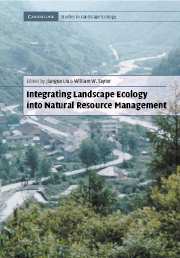Book contents
- Frontmatter
- Contents
- List of contributors
- Foreword
- Preface
- Acknowledgments
- PART I Introduction and concepts
- PART II Landscape structure and multi-scale management
- PART III Landscape function and cross-boundary management
- PART IV Landscape change and adaptive management
- PART V Landscape integrity and integrated management
- 14 Putting multiple use and sustained yield into a landscape context
- 15 Integrating landscape ecology into fisheries management: A rationale and practical considerations
- 16 Applications of advanced technologies in studying and managing grassland landscape integrity
- 17 An integrated approach to landscape science and management
- PART VI Syntheses and perspectives
- Index
- Plate Section
16 - Applications of advanced technologies in studying and managing grassland landscape integrity
Published online by Cambridge University Press: 14 January 2010
- Frontmatter
- Contents
- List of contributors
- Foreword
- Preface
- Acknowledgments
- PART I Introduction and concepts
- PART II Landscape structure and multi-scale management
- PART III Landscape function and cross-boundary management
- PART IV Landscape change and adaptive management
- PART V Landscape integrity and integrated management
- 14 Putting multiple use and sustained yield into a landscape context
- 15 Integrating landscape ecology into fisheries management: A rationale and practical considerations
- 16 Applications of advanced technologies in studying and managing grassland landscape integrity
- 17 An integrated approach to landscape science and management
- PART VI Syntheses and perspectives
- Index
- Plate Section
Summary
Introduction
Grasslands occupy large fractions of every continent except Antarctica (Knapp et al., 1998). In the United States, the Great Plains are generally divided into three regions: short-grass steppe in the west, mixed-grass in the center, and tallgrass prairie to the east (Reichman, 1987). The tallgrass prairie once stretched from central Canada to the Texas Gulf Coast and from eastern Kansas into Indiana. While large tracts of short- and mixed-grass grasslands still exist throughout the western Great Plains, it is estimated that 95.9% of the tallgrass prairie has been lost to agriculture. Illinois, Indiana, Iowa, North Dakota, and Wisconsin have lost 99.9% of their original tallgrass prairie (Samson and Knopf, 1994). The only extensive tract of tallgrass prairie that remains is the Flint Hills region of eastern Kansas, on the western, drier edge of the tallgrass prairie (Knapp et al., 1998) (Fig. 16.1).
Today, the tallgrass prairie is highly fragmented. Outside of the Flint Hills region, most prairies are remnants, often found in old cemeteries or railroad rights-of-way (Betz and Lamp, 1988). These prairies are often smaller than a hectare and usually isolated by tens of kilometers from the nearest remnant. The regional landscape of the tallgrass prairie region today is dominated by row-crop agriculture.
Grasslands provide multiple challenges to natural resource managers. Grasslands are often a complex mosaic of private, state, and federal land ownership. Land cover can consist of native or introduced (brome and fescue) species, small forests or woodlots, and agricultural crops. Land use can consist of grazing by livestock, row-cropping, and more recently residential development.
Information
- Type
- Chapter
- Information
- Integrating Landscape Ecology into Natural Resource Management , pp. 390 - 411Publisher: Cambridge University PressPrint publication year: 2002
Accessibility standard: Unknown
Why this information is here
This section outlines the accessibility features of this content - including support for screen readers, full keyboard navigation and high-contrast display options. This may not be relevant for you.Accessibility Information
- 1
- Cited by
